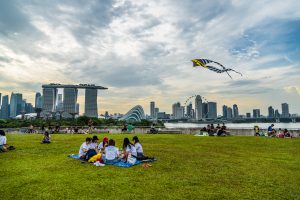The Evolution of multi-Ethnic Singaporean Families
September 6, 2021

Eat with your Family Day started in 2003 as an attempt to increase bonding time for Singaporean families. On designated days of the year, companies are urged to grant early leave, at 5pm, for employees to return to their families and have dinner together. This effort by the Centre for Fathering (CFF) is reflective of the pressures a rapidly evolving economy exerts on family life. “Origin and Transition of Singapore Families” (Family and Population Changes in Singapore, 2017) by Assistant Professor Zheng Mu (NUS Department of Sociology) and Dr Shu Hu (SUSS Department of Sociology) maps the evolution of family structures over Singapore’s history of socio-economic development. The chapter focuses on the three largest ethnic groups in Singapore – Chinese, Malay, and Indian. Differing in size, historical origins, migration history, religion and culture, these ethnic groups have earlier varied in patterns of marriage and fertility but have demonstrated a convergence in behaviours over recent years.
The historic origins of the different ethnic families differ greatly. Malays have been deemed the indigenous people of Singapore. Initially, heavy migration from the Malay Peninsula led to Malays becoming the majority population in Singapore until the 1830s, after which Chinese immigrants outnumbered the Malays and have remained a majority since. Mainly able-bodied Chinese men migrated to Singapore to engage in agricultural trade or tin-mining in the mid-19th century but colonial regulations to steady labour supply saw the migration of more Chinese women. The Malacca Chinese or Peranakan community descended from Chinese immigrants inter-marrying to Malays. Indians arrived in Singapore as businessmen, imperial auxiliaries, and labourers in 1824 and have been the ethnic minority since. Though most were from Tamil Nadu, both South and North Indians resided in Serangoon amidst Hindu, Muslim, and Christian places of worship. This area was later named “Little India”.
The profiles of Singapore families altered drastically from 1947 to 1970. Among the three ethnic groups, early marriages were most common in the Malay community which had the lowest percentage of single women. In contrast, the Chinese community had the highest percentage of single women. Perceived as a contract, nearly half of Malay marriages ended in divorce in the early 1900s. Divorce was least common in Chinese marriages. Living arrangements differed as well. It was more common for newlywed Malay couples to live with the bride’s parents until childbirth, and nuclear Malay families were more common. The older generation of Indians had arranged or guided marriages in which parents selected their children’s spouses.
Across the three ethnic groups, contemporary Singapore families now have a more stable sex ratio and smaller family sizes. Marriages are administered by two legislation systems – the Women’s Charter, for non-Muslim marriages, and the Administration of Muslim Law Act, for Muslim marriages. In both systems, the percentage of inter-ethnic marriages registered have increased from 1965 to 2014. The rate of inter-ethnic marriages is highest among Indian men and women, and lowest among Chinese men and women. These inter-ethnic interactions can be accredited to the public housing system and improving education in Singapore. Transnational marriages, between a citizen and non-citizen spouse, have also increased over time.
As Singaporean society has rapidly evolved amidst economic development, the different ethnicities have accepted the shift towards modern family behaviours. Over time, Chinese, Malay, and Indian families have begun to display more similarities to each other than their ethnic counterparts across the globe.
Access the book chapter here.

